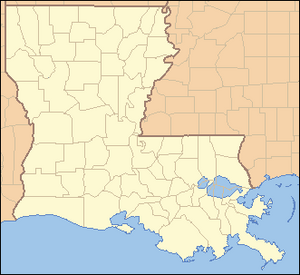List of parishes in Louisiana facts for kids
Quick facts for kids Parishes of Louisiana |
|
|---|---|
| Category | Second-level administrative division |
| Location | State of Louisiana |
| Number | 64 Parishes |
| Populations | Greatest: 448,467 (East Baton Rouge Parish) Least: 3,764 (Tensas Parish) Average: 71,465 |
| Areas | Largest: 2,429 square miles (6,290 km2) (Plaquemines Parish) Smallest: 203 square miles (530 km2) (West Baton Rouge Parish) Average: 781 square miles (2,020 km2) |
| Government | Parish government |
| Subdivisions | cities, Towns, Census designated place, Unincorporated area |
Louisiana is a unique U.S. state because it uses "parishes" instead of "counties" for its local government areas. There are 64 parishes in Louisiana. This is similar to how Alaska has "boroughs."
The word "parish" comes from the time when Louisiana was a colony of France and Spain. Back then, local government was often linked to church areas, called parishes.
Most parishes (38 of them) are run by a group called a police jury. The other 26 parishes have different kinds of governments. These include a council-president, a council-manager, or a combined parish/city government.
Contents
History of Louisiana's Parishes
Louisiana's history is tied to its French and Spanish past. Both countries were officially Roman Catholic. Because of this, local government areas were often based on church parishes.
After the Louisiana Purchase in 1803, the area became the Territory of Orleans. This territory was divided into 12 "counties." These counties had unclear borders but often used the same names as the old colonial parishes.
On March 31, 1807, the government created 19 new parishes. They didn't get rid of the old counties right away. In 1811, Louisiana prepared to become a state. The state was organized into seven judicial districts, which were groups of parishes.
By 1816, official maps of Louisiana started using the term "parish." The state's constitution in 1845 also used "parish." Since then, "parishes" has been the official name for Louisiana's main local divisions.
The first 19 parishes grew over time. In 1808, Catahoula Parish was added. In 1810, four more parishes were created from the former Spanish West Florida territory. These are now part of what's known as the Florida Parishes.
By April 1812, Attakapas Parish became St. Martin Parish and St. Mary Parish. On April 30, 1812, Louisiana officially joined the Union with 25 parishes.
More parishes were added or divided over the years. For example, Washington Parish was added by 1820. Feliciana Parish split into East and West Feliciana in 1824. During the Reconstruction Era, many new parishes were formed. This included Iberia and Richland parishes in 1868. Tangipahoa and Grant parishes followed in 1869.
In 1870, Cameron Parish was created. Red River, Vernon, and Webster parishes were formed in 1871. Lincoln Parish, named after President Abraham Lincoln, was created in 1873. In 1877, Carroll Parish split into East and West Carroll parishes.
No new parishes were formed until 1886, when Acadia Parish was created. Then, in 1908, LaSalle Parish was formed from Catahoula Parish.
The parish count reached 61 in 1910 with Evangeline Parish. The last three parishes (Allen, Beauregard, and Jefferson Davis) were created in 1912 from parts of Calcasieu Parish. This brought the total to 64 parishes. There have been only small boundary changes since then.
Louisiana's Parishes: A Quick Look
Here are a few examples of Louisiana's parishes:
| Parish |
FIPS code | Parish Seat | Est. | Origin | Etymology | Population | Area | Map |
|---|---|---|---|---|---|---|---|---|
| Acadia Parish | 001 | Crowley | 1886 | from part of St. Landry Parish. | From Acadian French. Named for the Acadians who settled the area. | 56,489 | 658 sq mi (1,704 km2) |
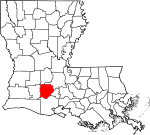 |
| Allen Parish | 003 | Oberlin | 1912 | from part of Calcasieu Parish. | Henry Watkins Allen, the Confederate governor of Louisiana | 22,112 | 766 sq mi (1,984 km2) |
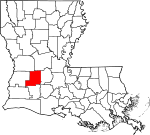 |
| Ascension Parish | 005 | Donaldsonville | 1807 | One of the original 19 parishes. | Named for the Ascension of Our Lord Catholic Church in Donaldsonville, Louisiana, which was named after the Ascension of Jesus into Heaven | 131,632 | 303 sq mi (785 km2) |
 |
| Assumption Parish | 007 | Napoleonville | 1807 | One of the original 19 parishes. | Named for Church of the Assumption of the Blessed Virgin Mary in Plattenville, the oldest in the state, which was named after the Assumption of the Virgin Mary | 20,160 | 364 sq mi (943 km2) |
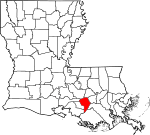 |
| Avoyelles Parish | 009 | Marksville | 1807 | One of the original 19 parishes. | The Avoyel Native American people | 38,408 | 866 sq mi (2,243 km2) |
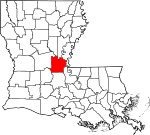 |
| Beauregard Parish | 011 | DeRidder | 1912 | from part of Calcasieu Parish. | Confederate general P. G. T. Beauregard | 36,827 | 1,166 sq mi (3,020 km2) |
 |
| Bienville Parish | 013 | Arcadia | 1848 | from part of Claiborne Parish. | Named after the founder of the city of New Orleans, Jean-Baptiste Le Moyne de Bienville | 12,366 | 822 sq mi (2,129 km2) |
 |
| Bossier Parish | 015 | Benton | 1843 | from part of Claiborne Parish. | U.S. Representative Pierre Bossier | 129,795 | 867 sq mi (2,246 km2) |
 |
| Caddo Parish | 017 | Shreveport | 1838 | from part of Natchitoches Parish. | Named for the Caddo Native American people | 226,386 | 937 sq mi (2,427 km2) |
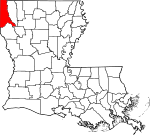 |
| Calcasieu Parish | 019 | Lake Charles | 1840 | from part of St. Landry Parish. | From Atakapa Calcasieu, meaning crying eagle, is said to be the name of an Atakapa Native American leader | 203,761 | 1,094 sq mi (2,833 km2) |
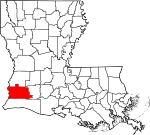 |
| Caldwell Parish | 021 | Columbia | 1838 | from part of Catahoula Parish and Ouachita Parish. | Named for the Caldwell family, which owned a large plantation and remains politically active in the state. | 9,389 | 541 sq mi (1,401 km2) |
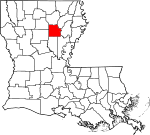 |
| Cameron Parish | 023 | Cameron | 1870 | from parts of Calcasieu Parish and Vermilion Parish. | U.S. Secretary of War Simon Cameron | 4,768 | 1,932 sq mi (5,004 km2) |
 |
Former Parishes
Some parishes that existed in the past no longer do. They were either renamed, divided, or merged with other areas.
- Attakapas Parish existed from 1805 to 1811.
- Biloxi Parish was formed in 1811. It was later moved to the Mississippi Territory in 1812.
- Carroll Parish was created in 1838. In 1877, it was split into East Carroll Parish and West Carroll Parish.
- Feliciana Parish was formed in 1810. In 1824, it was divided into East Feliciana Parish and West Feliciana Parish.
- German Coast Parish existed from 1805 to 1807.
- Opelousas Parish was renamed to St. Landry Parish in 1805.
- Pascagoula Parish was formed in 1811. It was also moved to the Mississippi Territory in 1812.
- Warren Parish existed from 1811 to 1814. It merged into Concordia and Ouachita Parishes.
Original Counties in 1803
When the Territory of Orleans was first created in 1803, it was divided into 12 "counties." These were the first main divisions of the area.
- Acadia Parish
- Attakapas County
- Concordia Parish
- German Coast County
- Iberville Parish
- Lafourche Parish
- Natchitoches Parish
- Opelousas County
- Orleans County
- Ouachita Parish
- Pointe Coupee Parish
- Rapides Parish
In 1807, German Coast County was divided into several new parishes. Attakapas County was also divided in 1811. The names "German Coast" and "Attakapas" were no longer used once these areas became parishes or were split up.
See also
 In Spanish: Anexo:Parroquias de Luisiana para niños
In Spanish: Anexo:Parroquias de Luisiana para niños
- List of United States counties and county equivalents


